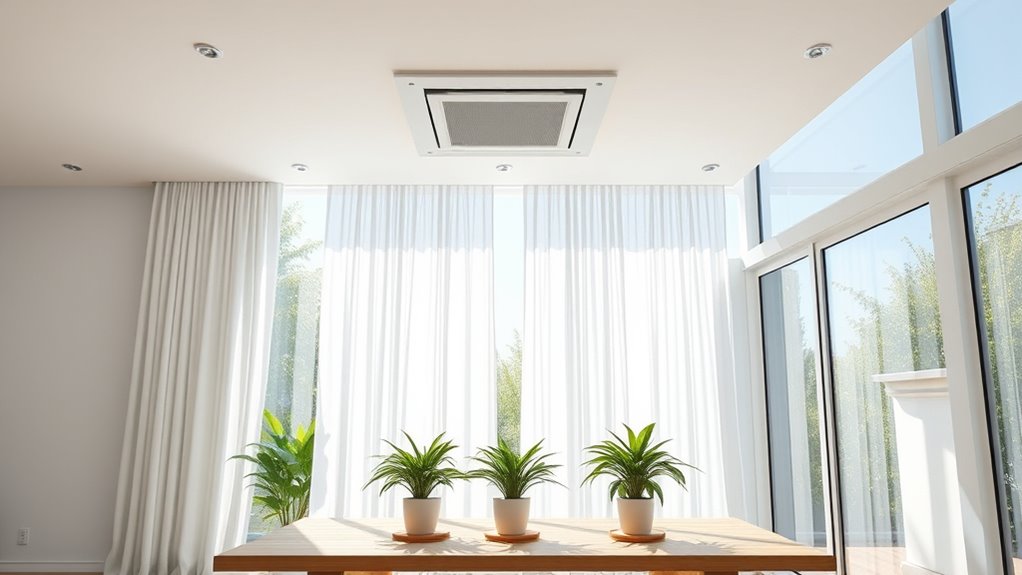To reduce VOCs with ventilation and air exchange, regularly open windows and doors to promote natural airflow, especially during favorable weather. Use cross-ventilation by opening opposite windows for better air movement. Consider installing mechanical ventilation systems that bring in fresh air and exhaust indoor pollutants, and guarantee they are well-maintained. Combining these strategies with source control can substantially improve indoor air quality—continue exploring for more practical tips to make your space healthier.
Key Takeaways
- Increase natural ventilation by regularly opening windows, especially during cooler, less humid times, to promote air exchange.
- Use cross-ventilation by opening windows on opposite sides of rooms to maximize airflow and VOC removal.
- Install and maintain mechanical ventilation systems with high airflow rates and proper filters for continuous VOC reduction.
- Schedule ventilation during peak VOC emission periods, such as after cleaning or using new products, to dilute indoor pollutants.
- Combine ventilation with source control by reducing VOC-emitting products and increasing indoor air exchange for optimal air quality.
Understanding VOCs and Their Impact on Indoor Air Quality
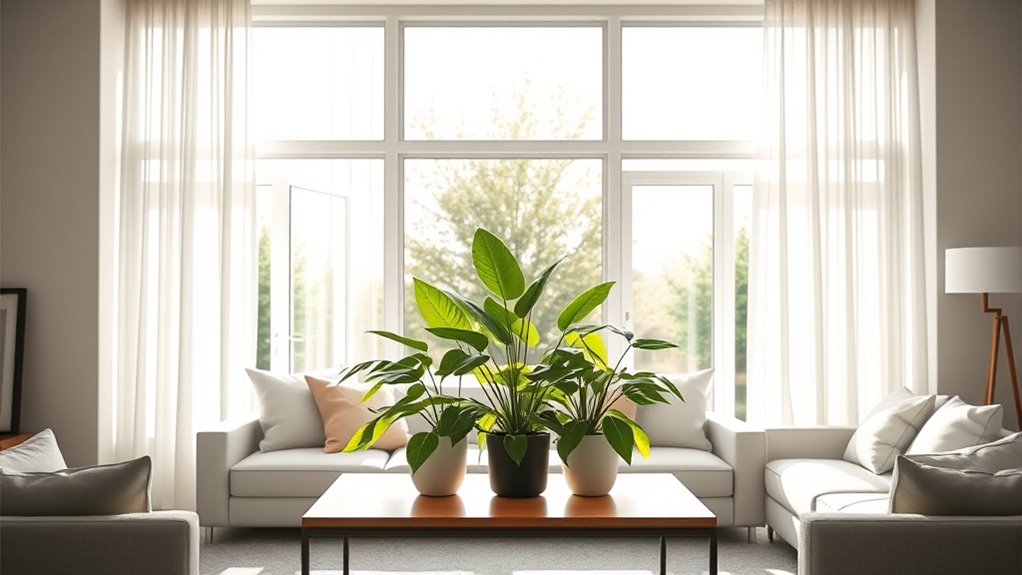
VOCs, or volatile organic compounds, are gases emitted from many common household products and building materials. These emissions can markedly affect indoor air quality by altering indoor air chemistry. When VOCs accumulate, they pose VOC health risks, including respiratory issues, headaches, and long-term health concerns. Understanding how VOCs impact your environment helps you recognize the importance of proper ventilation. Indoor air chemistry changes as VOCs react with other indoor pollutants, creating secondary compounds that may be even more harmful. Knowing the sources and behavior of VOCs empowers you to take steps to improve air quality. Ventilation plays a key role in diluting and removing these gases, reducing their concentration and safeguarding your health in your home or office. Effective air exchange is essential for maintaining a healthier indoor environment by continually replacing stale indoor air with fresh outdoor air.
Identifying Sources of VOCs in Your Home or Office
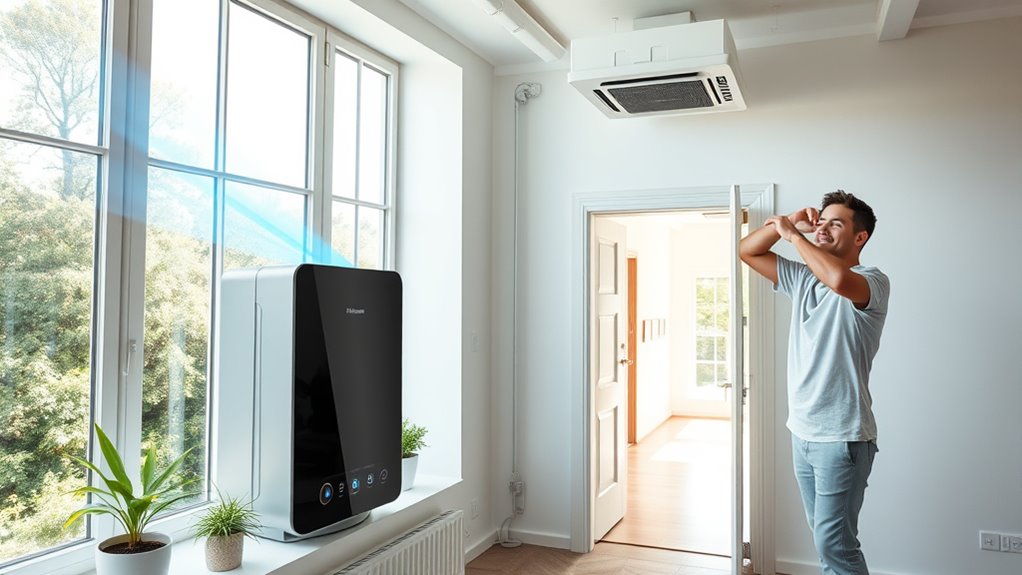
Many common household products and building materials release volatile organic compounds (VOCs) into your indoor environment. To effectively reduce VOCs, you need to identify their sources. Start by inspecting the following:
- Cleaning products and air fresheners – These often contain chemicals that emit VOCs.
- Building materials – Items like paint, varnishes, and new furniture can off-gas VOCs for weeks or months.
- Indoor plants and air purifiers – While indoor plants can help improve air quality, some may release VOCs if treated with chemicals. Air purifiers with activated carbon filters can help remove VOCs from the air.
Improving Natural Ventilation Through Strategic Window and Door Use

Opening windows and doors at strategic times can substantially enhance natural ventilation and reduce indoor VOC levels. By optimizing seasonal window use, you create natural airflow pathways that promote fresh air exchange. For example, opening windows opposite each other encourages cross-ventilation, removing VOCs efficiently. Timing is key—ventilate during cooler, less humid parts of the day to maximize airflow without energy loss. Use this table to plan your ventilation strategy:
| Season | Best Window Use | Airflow Strategy |
|---|---|---|
| Summer | Open windows at dawn or dusk | Cross-ventilation with doors |
| Winter | Slightly open windows briefly | Short, controlled airflow |
| Spring | Keep windows open longer | Maximize natural airflow pathways |
This approach boosts indoor air quality naturally, reducing VOC buildup effectively.
Selecting and Installing Effective Mechanical Ventilation Systems
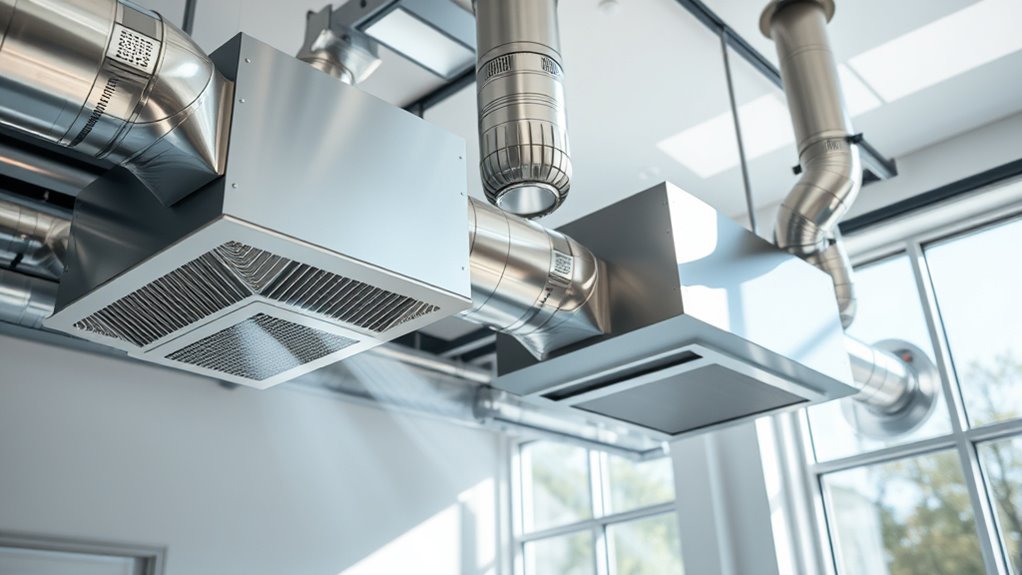
Choosing the right mechanical ventilation system is essential for maintaining healthy indoor air quality, especially when natural ventilation isn’t enough. You want a system that balances energy efficiency with effective air exchange while minimizing system noise. To select the best option, consider these factors:
- Energy efficiency—look for units with high SEER or ACH ratings to save on energy costs.
- Noise levels—choose systems designed for quiet operation to avoid disrupting your daily activities.
- Compatibility and installation—ensure the system fits your space and is straightforward to install without extensive modifications.
- Proper ventilation rates—select systems that provide adequate air exchange to effectively reduce VOCs and improve air quality.
Maintaining Ventilation Systems for Optimal Air Exchange

To keep your ventilation system working efficiently, you need to perform regular inspections and upkeep. Checking for issues and replacing filters as needed guarantees proper air exchange and reduces VOC buildup. Staying on top of these routines helps maintain a healthier indoor environment. Consistent filter maintenance ensures optimal performance and prolongs the lifespan of your ventilation system.
Regular System Inspections
Regular system inspections are essential to guarantee your ventilation systems operate effectively and maintain ideal air exchange. Regular checks help identify issues that could compromise air quality and reduce ventilation efficiency. By inspecting components like fans, ducts, and vents, you ensure everything functions smoothly. This prevents blockages, leaks, or malfunctions that can lead to VOC buildup. Keeping your system in top shape supports clean, fresh air and reduces airborne pollutants. Additionally, inspecting for proper airflow ensures the system is functioning at optimal capacity, directly contributing to healthier indoor air quality.
Filter Maintenance Routines
Maintaining your ventilation system’s filters is essential for guaranteeing peak air exchange and reducing VOC levels. Clean filters improve air purifier effectiveness and extend filter lifespan, keeping indoor air healthier. Regularly check and replace filters based on manufacturer recommendations to prevent dirt buildup that hampers airflow. A well-maintained system ensures fresh, clean air circulates efficiently, reducing harmful VOCs. Proper filter maintenance also helps prevent the buildup of contaminants that can diminish overall air quality.
Additional Tips for Minimizing VOC Levels Indoors
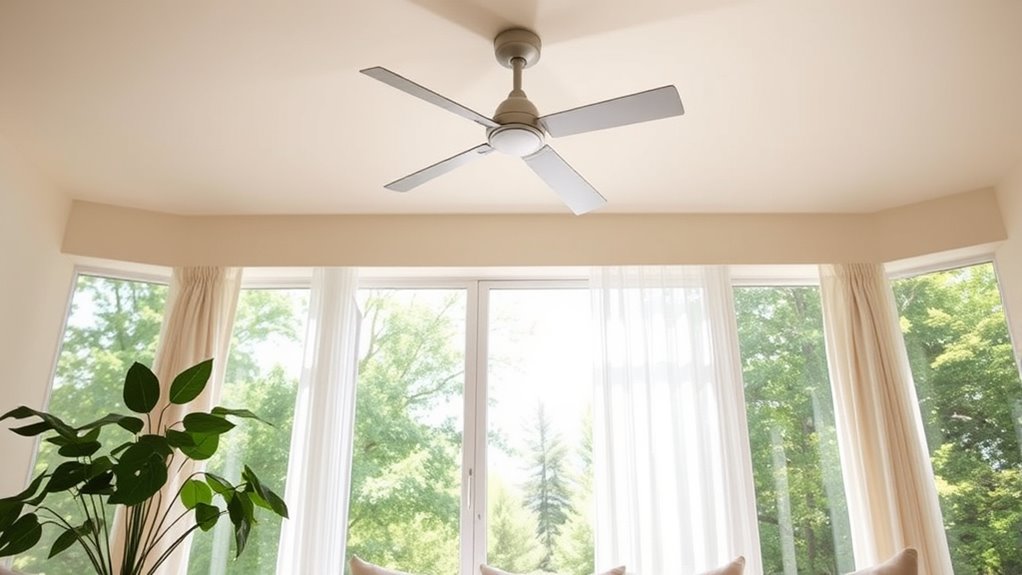
Implementing simple habits can substantially reduce VOC levels indoors. First, consider air purifier benefits—using a high-quality air purifier can filter out airborne VOCs effectively. Second, explore indoor plant strategies; certain plants like snake plants and pothos naturally absorb VOCs, improving air quality. Third, avoid storing chemicals or new furniture in your living space for extended periods, as they release VOCs over time. Regularly cleaning surfaces and choosing low-VOC products also help. Incorporating air purification technology can further enhance indoor air quality and reduce VOCs. Combining these tips with proper ventilation creates a healthier environment. By actively managing sources and enhancing air quality through these strategies, you’ll reduce VOCs considerably and enjoy cleaner, safer indoor air.
Frequently Asked Questions
How Often Should I Test Indoor VOC Levels?
You should test indoor VOC levels regularly to sustain good indoor air quality. It’s best to check at least every few months, especially if you notice odors or symptoms like headaches. Keep an eye on your air exchange rate, which helps control VOCs. Frequent testing ensures you’re aware of changes and can take action to improve ventilation, ultimately reducing VOCs and maintaining a healthier indoor environment.
Can Plants Help Reduce VOCS Indoors?
Imagine your indoor air quality as a busy highway of invisible pollutants. Plants act like natural filters, transforming VOCs into harmless substances through plant purification. While they won’t eliminate all VOCs, they can considerably improve air freshness and reduce harmful levels. Keep your green friends thriving, and they’ll work silently, enhancing your indoor environment. Remember, combining plant purification with proper ventilation creates a healthier, more breathable space for you to enjoy.
Are There Specific Ventilation Standards for VOC Control?
You ask if there are specific ventilation standards for VOC control. Yes, many building codes and standards, like ASHRAE 62.1, specify minimum air exchange rates to reduce indoor VOC levels. These standards guarantee proper ventilation to dilute and remove VOCs effectively. By following these guidelines, you can improve indoor air quality and minimize VOC exposure, ensuring a healthier environment in your space.
What Are the Best Times of Day to Ventilate?
The best times of day to ventilate are when outdoor air quality is at its peak, usually early mornings or late evenings. You should aim for high air exchange rates then, enabling natural ventilation to effectively reduce VOCs. Avoid ventilating during peak traffic hours or when pollution levels are high, as this can introduce more contaminants. Proper timing ensures ideal air quality and maintains a healthy indoor environment.
How Do HVAC Filters Impact VOC Removal Efficiency?
HVAC filters play a key role in VOC removal by capturing airborne chemicals through air filtration. You should choose high-efficiency filters designed for VOCs, like activated carbon filters, to improve air quality. Regular filter maintenance is essential; replacing filters as recommended prevents clogging and maintains peak air exchange. This combination ensures your system effectively reduces VOC levels, making your indoor environment healthier and safer.
Conclusion
By prioritizing proper ventilation and air exchange, you’re opening the door to fresher, healthier indoor air. Think of it as giving your space a breath of new life—each action, from opening windows to maintaining systems, acts as a crucial pulse for cleaner air. Remember, a well-ventilated environment isn’t just a choice; it’s a shield against VOCs, ensuring your home or office remains a sanctuary of safety and well-being.
